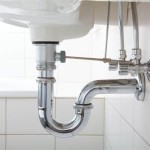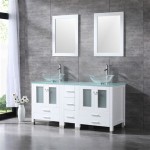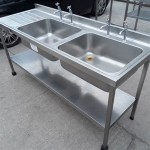Bathroom Sink Faucet and Drain: A Comprehensive Guide
The bathroom sink faucet and drain are essential components of any functional bathroom. These seemingly simple fixtures play a critical role in water delivery, waste removal, and the overall aesthetic of the space. Understanding the different types, features, and considerations when selecting these components is crucial for ensuring a long-lasting and satisfactory bathroom experience.
The faucet serves as the control point for water flow, allowing users to adjust temperature and pressure as needed. The drain, on the other hand, is responsible for efficiently channeling wastewater away from the sink basin and into the plumbing system while preventing unwanted odors and debris from entering the bathroom. The interplay between these two components is fundamental to the functionality and hygiene of the bathroom environment.
This article will explore the various aspects of bathroom sink faucets and drains, providing detailed information on types, materials, installation, maintenance, and troubleshooting. This information aims to provide a comprehensive understanding of these fixtures, enabling informed decisions when selecting, installing, or repairing them.
Types of Bathroom Sink Faucets
Bathroom sink faucets come in a variety of styles, each designed to complement different sink configurations and aesthetic preferences. Understanding the different types is paramount to selecting the appropriate faucet for a specific bathroom design.
Centerset Faucets: These faucets are designed for sinks with three pre-drilled holes, typically spaced 4 inches apart. The faucet body, spout, and handles are all integrated into a single unit. This type is often a cost-effective and straightforward option for standard bathroom sinks.
Single-Hole Faucets: As the name suggests, single-hole faucets require only one hole in the sink or countertop. These faucets often feature a single lever or knob for controlling both water temperature and flow. Their clean and minimalist design makes them a popular choice for modern bathrooms.
Widespread Faucets: Widespread faucets are characterized by their separate hot and cold water handles, which are mounted independently from the spout. These faucets require three holes, typically spaced 8 inches or more apart, allowing for a more customizable and visually appealing installation. Widespread faucets are often associated with higher-end bathroom designs.
Vessel Faucets: These faucets are specifically designed for vessel sinks, which sit above the countertop rather than being integrated into it. Vessel faucets are typically taller than other faucet types to accommodate the height of the vessel sink. They come in a variety of styles, including single-handle and two-handle options.
Wall-Mounted Faucets: Wall-mounted faucets are installed directly onto the wall, freeing up countertop space and creating a clean and contemporary look. These faucets require careful planning during the plumbing installation phase to ensure proper placement and functionality. They are often more complex to install than deck-mounted faucets.
Beyond the basic types, faucet designs also vary significantly in terms of spout shape, handle style, and finish. Common spout types include low-arc, high-arc, and waterfall spouts. Handle styles range from traditional cross handles to sleek lever handles. Faucet finishes can range from polished chrome to brushed nickel to oil-rubbed bronze, offering a wide array of options to match any bathroom décor.
Types of Bathroom Sink Drains
The drain assembly facilitates the removal of wastewater from the sink. While seemingly simple, understanding the different types of bathroom sink drains and their mechanisms is essential for proper function and preventing leaks or clogs.
Pop-Up Drains: Pop-up drains are one of the most common types of bathroom sink drains. They feature a stopper that can be raised and lowered by a lever located behind the faucet or on the drain body itself. When the lever is activated, it pulls on a connecting rod, which in turn lifts or lowers the stopper, allowing water to drain or be held in the sink.
Lift-Rod Drains: Similar to pop-up drains, lift-rod drains also utilize a stopper activated by a lever. However, the lever is typically located behind the faucet, and the connecting rod is more complex. This type is commonly found in older bathroom fixtures.
Push-Button Drains: Push-button drains, also known as touch-down drains, are activated by pressing down on the stopper. Pressing the stopper once seals the drain, while pressing it again releases it. This type is popular for its ease of use and clean appearance, as there is no external lever or rod required.
Grid Drains: Grid drains feature a fixed grate or grid that prevents large objects from entering the drainpipe. These drains do not have a stopper and are typically used in sinks that do not require the ability to hold water, such as those in commercial settings or some modern residential designs.
Flip-Top Drains: Flip-top drains have a stopper that can be flipped over to either seal or open the drain. These drains are simple to operate and have a clean, minimalist appearance. They are less common than pop-up or push-button drains.
The material used in the drain construction is also a significant factor. Options include brass, stainless steel, and plastic. Brass drains are generally more durable and resistant to corrosion, while stainless steel offers a sleek appearance and good corrosion resistance. Plastic drains are more affordable but may be less durable.
Regardless of the type, all bathroom sink drains include several components: the drain flange (which sits within the sink basin), the drain body (which connects the flange to the drainpipe), a stopper (if applicable), and a tailpiece (which connects to the P-trap).
Key Considerations for Selection and Installation
Choosing the right bathroom sink faucet and drain involves several considerations, including compatibility with the sink, plumbing system, intended use, and aesthetic preferences. Proper installation is equally important for ensuring long-term performance and preventing leaks or other issues.
Sink Compatibility: The first step is to ensure that the faucet and drain are compatible with the existing sink. This includes verifying the number of holes in the sink, the spacing between the holes, and the sink's overall style. For example, a centerset faucet will not work with a sink that only has one pre-drilled hole, and a vessel faucet is designed specifically for a vessel sink. Similarly, the drain must be the correct size and type for the sink's drain opening.
Plumbing System Compatibility: The faucet and drain must also be compatible with the existing plumbing system. This includes understanding the size and type of water supply lines and drainpipes. Most bathroom faucets use standard ½-inch or 3/8-inch water supply connections. The drain tailpiece must also connect properly to the P-trap, which is a curved section of pipe that traps debris and prevents sewer gases from entering the bathroom.
Material and Finish: The material and finish of the faucet and drain should be durable, corrosion-resistant, and aesthetically pleasing. Common faucet materials include brass, stainless steel, and zinc alloys. Finishes can range from polished chrome to brushed nickel to oil-rubbed bronze. The drain should be constructed of a material that is resistant to corrosion and clogs, such as brass or stainless steel.
Ease of Use and Maintenance: Consider the ease of use and maintenance when selecting a faucet and drain. Single-handle faucets are often easier to operate than two-handle faucets, while push-button drains are generally easier to clean than pop-up drains. Choose a finish that is easy to clean and maintain, and avoid complex designs that are difficult to reach and clean. Regular cleaning and maintenance are essential for preventing clogs and extending the lifespan of the faucet and drain.
Installation: Proper installation is crucial for ensuring long-term performance and preventing leaks. If you are not comfortable with plumbing tasks, it is best to hire a qualified plumber to install the faucet and drain. The installation process typically involves several steps, including turning off the water supply, disconnecting the old faucet and drain, installing the new faucet and drain, connecting the water supply lines and drainpipe, and testing for leaks.
Troubleshooting: Even with proper installation and maintenance, faucets and drains can sometimes experience problems. Common issues include leaks, clogs, and reduced water pressure. Leaks can often be resolved by tightening connections or replacing worn-out washers or O-rings. Clogs can be removed using a plunger, drain snake, or chemical drain cleaner. Reduced water pressure can be caused by mineral buildup in the faucet or pipes.
Selecting the appropriate bathroom sink faucet and drain involves careful consideration of these factors. When chosen and installed properly, these components contribute to a functional, aesthetically pleasing, and hygienic bathroom environment.
Bathroom Sink Drain Ing Guide Signature Hardware

Blue Bathroom Sink Tempered Glass Vessel Basin Bowl Combo Faucet Drain Set

Forious Waterfall Single Handle Bathroom Faucet With Metal Pop Up Drain Sink Matte Black In Hh0302bd

Pink Hand Painting Oval Bathroom Tempered Glass Vessel Sink Faucet Drain Combo

How To Install Bathroom Sink Drain Faucet No Leaks Under Gasket Threads Solved 2024

Stainless Steel Bathroom Sink Faucet With Lift Rod Drain Kraus

How To Replace And Install A New Bathroom Faucet Pop Up Drain In 7 Minutes Builds By Maz

Bathlet Widespread Bathroom Sink Faucet With Drain Assembly Matte Black

4 Inch Centerset Bathroom Faucets With Lift Rod Drain Stopper Gotonovo

Forious Two Handles Widespread Brass Bathroom Faucet With Pop Up Drain Assembly Sink Cupc Water Supply Hh0301bn







